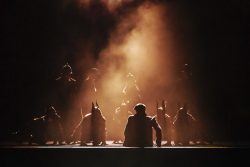 WALKING past the stage door after the show, I was overtaken by a petite young lady desperately attempting to explain to her very large companion (he could have been cast as an arch tough guy in Peaky Blinders) that what they had been watching was not a narrative tale, but one full of serial symbolism. And there in a nutshell is the problem facing the exciting Rambert company in presenting a show with Peaky Blinders written large and clear on its publicity.
WALKING past the stage door after the show, I was overtaken by a petite young lady desperately attempting to explain to her very large companion (he could have been cast as an arch tough guy in Peaky Blinders) that what they had been watching was not a narrative tale, but one full of serial symbolism. And there in a nutshell is the problem facing the exciting Rambert company in presenting a show with Peaky Blinders written large and clear on its publicity.
Although written by Steven Knight as a prologue to his highly successful TV series, this modern dance show never sets out to be a straightforward narrative tale.
Some of those who were attracted to the theatre mainly by the thought of seeing their favourite TV characters in further adventures on stage will be disappointed. Others among their number will be fascinated by Benoit Swan Pouffer’s choreography, and the way that as director he uses Roman Gianarthur’s specially written score. These audience members may not be immediate converts to modern dance, but the production will have opened up a whole new theatrical experience for them.
 The already converted will welcome a chance to see Rambert at their most unrelenting, paying no homage to easy access to the storyline or dance interpretation. Moi Tran’s two-tiered black set, with a gully between, is encased in black curtains, and with Natasha Chivers’ lighting design deliberately (for the most part) filling the stage with shadows, the mood is as intense and depressive as it needs to be, as the story unfolds of the four disillusioned Shelby brothers returning from fighting the “War to End all Wars”, to find a world definitely not fit to welcome heroes.
The already converted will welcome a chance to see Rambert at their most unrelenting, paying no homage to easy access to the storyline or dance interpretation. Moi Tran’s two-tiered black set, with a gully between, is encased in black curtains, and with Natasha Chivers’ lighting design deliberately (for the most part) filling the stage with shadows, the mood is as intense and depressive as it needs to be, as the story unfolds of the four disillusioned Shelby brothers returning from fighting the “War to End all Wars”, to find a world definitely not fit to welcome heroes.
Their survival, via gangsterism and descent into more violence, murder and drugs, is told mainly through the life of their leader, Tommy. Conor Kerrigan completely inhabits Tommy, taking him from proud soldier via bullying gangster to suicidal revengeful lover, as he seeks retribution for Grace, his beautiful murdered bride, (Naya Lovell). It all comes to a climax in an extended fight between the rival gangs, leading to Tommy’s death.
 As ghosts appear and we are invited inside Tommy’s head to see first-hand the things that drive his actions, symbolism and surrealism take over, and it only comes back to reality with the intervention of movingly-spoken recorded lines by, now alas dead, poet Benjamin Zephaniah.
As ghosts appear and we are invited inside Tommy’s head to see first-hand the things that drive his actions, symbolism and surrealism take over, and it only comes back to reality with the intervention of movingly-spoken recorded lines by, now alas dead, poet Benjamin Zephaniah.
Some expert illusionary effects by Filipe J Carvalho allow us to see the splendid musicians and singers Yarron Engler, Joe Downard and Mitchel Emms, literally floating around the stage. There is a great deal to see and hear, sometimes too much, distracting from the main thrust of the production and the evolving story of Tommy Shelby’s redemption.
 More signposts as to which character was taking centre stage, and clarity in the storytelling, would have placed the spotlight much more firmly on the dancers, who, in spite of these restrictions still, as they should, dominated the production … a fact that pleased the many modern dance fans who had come to see the Rambert company first and Peaky Blinders second.
More signposts as to which character was taking centre stage, and clarity in the storytelling, would have placed the spotlight much more firmly on the dancers, who, in spite of these restrictions still, as they should, dominated the production … a fact that pleased the many modern dance fans who had come to see the Rambert company first and Peaky Blinders second.
GRP
Photographs by Johan Persson